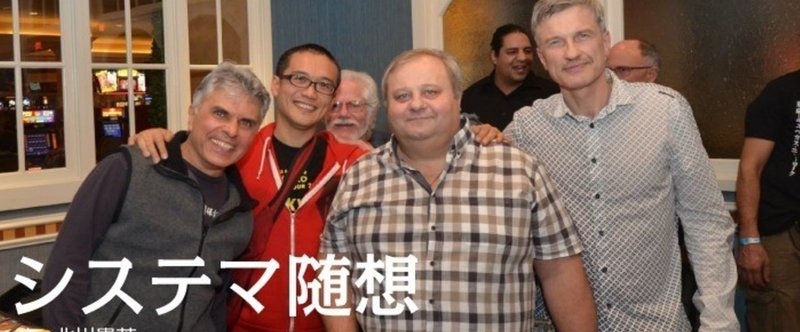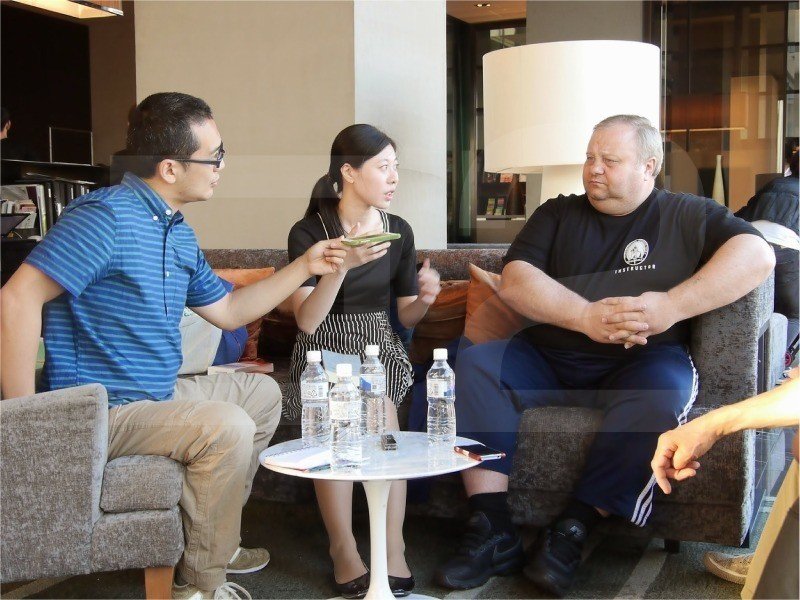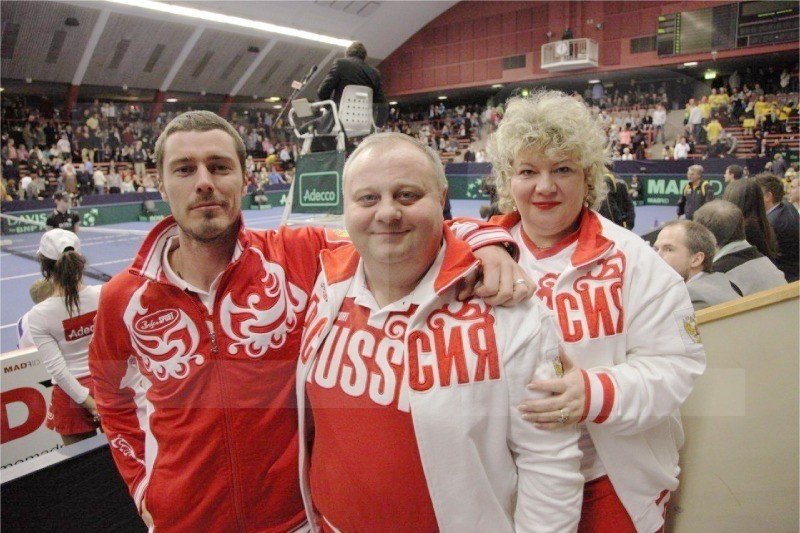
Stray notes about SYSTEMA "Interview with Mikhail Ryabko" by Takahide Kitagawa(Systema Tokyo)
Stray notes about SYSTEMA
Interview with Mikhail Ryabko
Re:Russian Masters and Japanese Martial Arts
Story●Takahide Kitagawa(Systema Tokyo)
Legendary Warriors in the Russian History
-I hear there were once many great warriors in Russia. Have you ever actually seen anyone like that?
Mikhail - I have seen a lot. I don't remember every one of them. However, in the past ten years or so, there have been no outstanding warriors in the army. The masters I regard highly were in the SMERSH (counter-intelligence agencies controlled directly by Stalin), but I cannot say their names even now. During the war, their mission was to capture the German spies.
They were acting under very difficult terms, as they were ordered not to kill or injure the enemies. That's because no information can be obtained from dead spies. If they killed them, they were punished. They were able to shoot well, of course, but they couldn't shoot. And naturally, they had to avoid being killed or captured, as that meant giving a lot of information to the enemies, and would have caused their families to become the target of the enemies' attacks.
Most of the masters I remember were actively fighting at the front. That's why they were so well trained. Every sport has its masters. It was the same for the army.

-What about the ancient times?
Mikhail - In terms of warriors, we should talk about ancient eras, rather than the Soviet era. In those days, people were fighting with swords. The eras of Prince Alexander Nevsky of Kievan Rus' (1220-1263, see https://en.wikipedia.org/wiki/Alexander_Nevsky), Mikhail of Tver (Mikhail Yaroslavich, 1271-1318, see https://en.wikipedia.org/wiki/Mikhail_of_Tver), the Grand Duchy of Vladimir-Suzdal (see https://en.wikipedia.org/wiki/Vladimir-Suzdal), to name a few. Also, Andrey Bogolyubsky (ca. 1111-1174, see https://en.wikipedia.org/wiki/Andrey_Bogolyubsky) was of the Grand Duchy of Vladimir-Suzdal. There is a legend about him like this.
One night, while he was sleeping, fifteen assassins assaulted him. He was sound asleep, with no swords around him. But he survived with only slight injuries. He took an enemy's sword and fought with it.
I've heard of another one, who was awarded the Order of Saint George. He fought alone against fifteen German cavalry and warded them off. He was slashed fifteen times with sabers and his horse was wounded, too, but he was walking around all right five days later. I've heard that, in the Russo‐Japanese War, the Japanese soldiers were ordered to always attack one Russian soldier in a group of three. Another famous warrior is General Suvorov (Alexander Suvorov, 1729-1800, see https://en.wikipedia.org/wiki/Alexander_Suvorov). He never experienced a defeat. When his troop fought with Germans, a hundred Germans were killed, but only one of his soldiers died. Every one of them were such a well-trained warrior.
In the Navy, there was Ushakov (Fyodor Ushakov, 1744-1817, see https://en.wikipedia.org/wiki/Fyodor_Ushakov). He fought with Turks and Germans many times, and was never defeated. There were also warriors in the era of "Tataro-Mongol Yoke." Peresvet (Alexander Peresvet, ??-1380, see https://en.wikipedia.org/wiki/Alexander_Peresvet) who defeated Chelubey, the Prince of Moscow Dmitry Donskoy (1350-1389, see https://en.wikipedia.org/wiki/Dmitry_Donskoy) who lead the Russian army in that battle, and in an earlier period, Daniel of Moscow (Daniil Aleksandrovich, 1261-1303, see https://en.wikipedia.org/wiki/Daniel_of_Moscow) were the examples of such warriors.
All those people were ideal masters. Russian warriors were baptized in childhood and they went to war at the age of eleven. As their homeland was surrounded by enemies, Cossacks were very good at bare hands fighting.
Where did Systema come from?
-In Systema, what is inherited unchanged from the ancient times?
Mikhail - It's from the era of King David (ca. 1000-961 B.C.). He sang and fought, sang and fought. He was a warrior sent by God. He was helped by Archangel Michael. They were praying as they fought.
King David is famous for killing Goliath with a sling, as it is told in the Old Testament. Our school has its roots in him. In other words, the roots of Systema goes back to Israel in the era before Christ. That means the greatest master ever was Archangel Michael (see https://en.wikipedia.org/wiki/Michael_%28archangel%29).
Look at the icon of Archangel Michael. He holds his sword with a relaxed and natural posture. This is how we aim to be. You can find a lot of images in the Internet.

-Have all elements of the current Systema come from the Ryabko family?
Mikhail - Partially, yes. I have collected the positive elements. The principle I have just spoken of is at the base of Systema.
-Did you add to what your grandfather was doing?
Mikhail - In a sense, yes. I have learned various things from my grandfather. But my father or grandfather knew nothing about, say, Japanese Karate or Aikido. Still, Systema was there. The Systema principles I'm talking about is based on what I learned from my father and grandfather, but they may not have considered those principles so important. Surely, they did not know what I know today. That's because those things were not so important at that time. My father knew nothing about Japanese martial arts or culture.
-Is Systema's technical roots the martial arts of the Cossacks, who were known as formidable cavalrymen?
Mikhail - As I have explained, its roots is in Israel, not Cossacks. Cossacks, at some point in their history, adopted Systema. It has come down through the Red Army to me. In its history, Rome may have been involved, or it may have passed through Greece. It has come down all the way like that. In that path, it has gone through numerous challenges up to now.
-Did you practice riding horses?
Mikhail - Since both my late father and my grandfather kept a horse, I sometimes rode them. But I sold the horse when my father died. It was just after the start of the 21st century, so it was not such a long time ago. When my father was alive, he was often taking care of his horse. Naturally, I rode very well. Since we kept a horse, it's funny if I didn't ride (laughs).
-Who chose the name "Systema?"
Mikhail - Vladimir Vasiliev and I did. One day, Vladimir called me from Toronto, saying, "We need a name for our school. What do you suggest?" He said he wanted a name that is easy to remember for everyone, so I said, "How about Systema?" That name contains everything in it, as a whole. I think it was after the year 2000. The name is new, but what it means remains unchanged. Names may vary, but the meaning is the same.
-I've heard that "Know Thyself" was one of the candidates.
Mikhail - It sure was, but it doesn't sound like a martial art, does it (laughs)? It is one of the principles, but it is not suitable for a name.
-What was it called before it was named Systema?
Mikhail - "The Martial Art of the ancient Rus." That was the first name. Systema is a trademark (laughs).
-The emblem of Systema, what does it mean?
Mikhail - The warrior drawn in the oval is Ilya Muromets (a famous Russian legendary hero and a character of oral epic poems "bylinas." See https://en.wikipedia.org/wiki/Ilya_Muromets). He is a warrior known to everyone in Russia. He is now buried in Kiev. I have once visited his grave. At the background of the emblem is the sun.

-Was his fight Systema?
Mikhail - In a sense, yes. He was a great warrior.
Japanese Martial Arts as Seen by Mikhail
-Like Russia, Japan is said to have had many masters in its history. What do you think about Japanese martial arts?
Mikhail - The term "martial arts" seems to be too general. I'd like to comment individually. As for Karate, the movement seems rather monotonous. The motion is broken up like, "one, two, one, two." The body seems fully tensed up, but I think, in its original form, the movement must have been without tension. You should tense up just a little at the moment of impact. The muscles used should be as few as possible.
And what does Kata mean? Kata should be without stagnation. The body should be relaxed, and the focus of your attention should be at the tip of your body. You should move without force. If you practice that way, it makes a great sense. Instead of using all your force, you should let your body move unforcefully.
Do Karate practitioners understand why Kata is necessary? Do they intend to use Kata in a real fight? In a real fight, the movement should not be broken up, it should be smooth. Kata is only meaningful if you practice it smoothly without stagnation. If memorized mechanically, it will take you nowhere.
If I had an opportunity to coach a Karate practitioner, I should be able to teach to move without tension. I highly estimate Karate as a martial art, but most of its practitioners today seem to be focusing only on superficial forms. Of course, it's nothing but my personal opinion. I said it because I was asked, and I have no intention to criticize.

-Thank you for answering a tricky question. How about Aikido? It is often said to be similar to Systema.
Mikhail - Aikido is a beautiful martial art, but I see a slight problem with it. I doubt if the Aikido we can see today is the same as the original. Morihei Ueshiba created the initial Aikido, from which many branches have emerged. What we see now may be the branches rather than the original Aikido. I think so because similar things have happened with Systema.
In Systema, I teach what I have been passed down from the past, gradually from the basics. But recently, some branches have shown up, and some people even claim that they know Systema better than Mikhail Ryabko. A few years ago, I started to teach the "internal work," which means to treat the body and the psyche from the inside. That's because I thought the suitable time has finally come. But some people who have learned the traditional Systema mistakenly believed that I quit teaching Systema, so they left, thinking they know better than I do. I suspect something similar has happened to Aikido.
I saw many great Aikido teachers in Aiki Expo (a grand event held in the US that gathered many famous Aikido and other martial art teachers. Mikhail was invited at the 2005 event as an instructor). They all respected the founder Morihei Ueshiba, but each of them had his own way of doing Aikido. That kind of separation makes the core teaching disappear.
We focus on relaxing the body and releasing tensions. But the internal senses tend to be overlooked. Every martial art, in its original form, must have had a way to leverage the opponent's force. Approaching the opponent without using force is inherently easy. On the other hand, if you try to overcome force with force, you need to make up various techniques. In Systema, we try to approach without using force.
I admit that those techniques to use force against force are sometimes effective, but in Systema, we focus on the internal way. In the traditional method to teach martial arts, the teacher first shows the example, and the disciples imitate it. The first thing to do, however, is to develop the internal strength. When the disciples become suitable for a fight, you can show them how to fight. That may be one of the ideas unique to Systema, compared to other martial arts.
-Please name some of the Japanese martial artists who have impressed you.
Mikhail - Recently, I was interested in the YouTube video of Mifune 10 dan. His motion was very beautiful and relaxed. When he demonstrated Kata, his back was straight, but in Randori (sparring), it was slightly bent. It might have been better if he kept his back straight even in a real fight. However, what Mifune 10 dan was doing does not seem to be quite aligned with what Judo in general is aiming at. Most Judo practitioners are more aggressive and militant, and tend to actively attack the opponent. I think the original Judo is a beautiful and practical martial art. It's much better if it's done unforcefully.
Fighting is very much like treating a woman you love. When you are going to sleep with your sweetheart, you lay her gently on the bed. You never throw her down violently. I suggest you practice Judo with that kind of love in your heart. If you approach your sweetheart with a fierce look, you will never get along with her. As martial arts are part of our lives, the same principles apply. Understanding, seeing, and teaching make us progress.

Russian top tennis player Marat Safin with Mikhail and his wife.
Mikhail coached him on how to use his body, so he invited Mikhail to the match. Marat Safin, see https://en.wikipedia.org/wiki/Marat_Safin.
-I hear some Russian top athletes practice Systema as part of their training. How is it done?
Mikhail - We teach how to use their muscles and how to breathe, according to the type of sports they are doing. After they have mastered how to breathe, we teach to synchronize the breathing with the movement. It's the same for every sport. After developing stamina with training, we strengthen the concentration. Both physical and mental stamina is necessary. As for tennis, one game lasts two to three hours, or in some cases five to six hours. Tennis players must be trained to endure physically and maintain their capabilities during that long period. Additionally, a problem specific to a tennis player is that one of the arms becomes thicker than the other. That overloads the elbow to eventually break it. Similarly, the knees are overloaded and the back is always tilted in a specific direction. We train them to be able to transform those disadvantages into advantages.
It's the same for soccer, basketball, Karate, Judo, Sambo, ski jumping, boxing, and table tennis. Systema is the foundation of all sports. Every athlete should learn it. Practitioners of every kind of sports and martial arts come to my school.
-Finally, could you give a message to the Systema practitioners in Japan?
Mikhail - I found some of the participants of the seminar had difficulty in understanding the theme. But as a whole, they are good, and they have surely made a progress.
Continue practicing Systema. Come to Moscow if possible, and see what is done there. Also, review what you have learned at the seminar.
-Thank you very much.
-- Profile --

著者●北川貴英 Takahide Kitagawa(Systema Tokyo)
08年、モスクワにて創始者ミカエル・リャブコより日本人2人目の公式システマインストラクターとして認可。システマ東京クラスや各地のカルチャーセンターなどを中心に年間400コマ以上を担当している。クラスには幼児から高齢者まで幅広く参加。防衛大学課外授業、公立小学校など公的機関での指導実績も有るほか、テレビや雑誌などを通じて広くシステマを紹介している。
著書
「システマ入門(BABジャパン)」、「最強の呼吸法(マガジンハウス)」
「最強のリラックス(マガジンハウス)」
「逆境に強い心のつくり方ーシステマ超入門ー(PHP文庫)」
「人はなぜ突然怒りだすのか?(イースト新書)」
「システマ・ストライク(日貿出版社)」
「システマ・ボディーワーク(BABジャパン)」
「ストレスに負けない最高の呼吸術(エムオンエンタテイメント)」
監修
「Dr.クロワッサン 呼吸を変えるとカラダの不調が治る(マガジンハウス)」
DVD
「システマ入門Vol.1,2(BABジャパン)」
「システマブリージング超入門(BABジャパン)」
web site 「SYSTEMA TOKYO」
この記事が気に入ったらサポートをしてみませんか?
![コ2 [kotsu] note分室](https://assets.st-note.com/production/uploads/images/3205/profile_68aaef9d6c5a7c05aa8739ed98bf9e59.png?width=60)